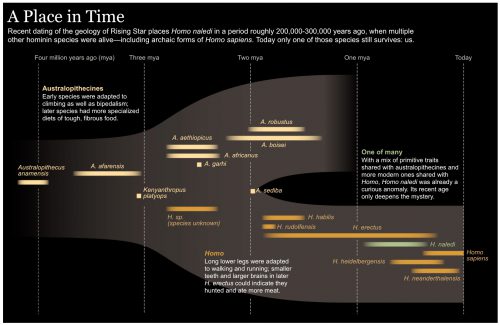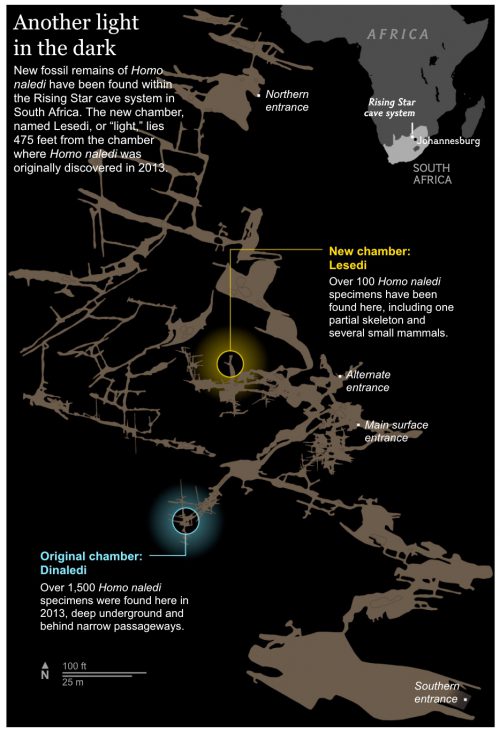When I first heard about Homo naledi, the question at the top of my head was “How old is it?” It was a hominin, it looked fairly primitive with a small brain the size of a gorilla’s, yet it was found in a mass “grave”, where part of the mystery was how so many dead hominins ended up in this difficult-to-reach, hidden cave system in South Africa. The authors didn’t report a date. Speculation ran from 3 million years old to 300 thousand years old, both dates seeming extreme and unlikely.
Now we have a date: between 236,000 and 335,000 years old. Astonishing.
That’s really young. Furthermore, they’ve found another chamber in the cave network with even more bones.
All indications are that this was a thriving population of little, primitive people.
The bones, remarkably, show few signs of disease or stress from poor development, suggesting that Homo naledi may have been the dominant species in the area at the time. “They are the healthiest dead things you’ll ever see,” said Berger.
Homo naledi stood about 150cm tall fully grown and weighed about 45kg. But it is extraordinary for its mixture of ancient and modern features. It has a small brain and curved fingers that are well-adapted for climbing, but the wrists, hands, legs and feet are more like those found on Neanderthals or modern humans. If the dating is accurate, Homo naledi may have emerged in Africa about two million years ago but held on to some of its more ancient features even as modern humans evolved.
It’s still a mystery how all these bones ended up in the caves. These don’t seem to be ceremonial burials, it’s more like they were chucking their dead down some hole to drop them in a deep cave.




They weren’t just chucking them down a hole — it’s quite laborious to get in and out of that cave.
Now it is. They speculate that there may have been easier ways to get in, or to drop bodies in, 300,000 years ago.
But they haven’t found any.
The BBC puns
Please no.
Hygienic disposal of otherwise rotting corpses seems an older impulse than burying rituals. Hooray for the Naledi and the women archeologist/paleontologists who brought them up.
=8)-DX
Well, they don’t have a time machine, only geologists. Perhaps if they got a geologist with self-tying shoes and a hoverboard, they’d know more about how the cave-structure changed over the millenia.
=8)-DX
It should be possible to identify any now-closed shaftways from within the chambers. There is zero indication. This is in fact puzzling to the investigators. I’m not putting my own two cents in on this, it’s a true enigma.
Could it be ‘we’ developed our bigger brain (the most wonderful thing ever evolved (/sarc) — to eventually destroy us all) in competition with the ‘more primitive’?
It will all become clear once they discover the bodies in the mass graves were the lawyers.
kevinv@#9:
It will all become clear once they discover the bodies in the mass graves were the lawyers.
Wouldn’t we expect a civilization without lawyers to do better? They died off. Maybe the dead are their philosophers.
When they first found the original set, I thought they might eventually prove to be to the younger side of the estimates…but not that young. Indeed there’s been quite an outburst of ‘little people’ in recent years – naledi and floresiensis. And they seem relatively recent – basically contemporary with neanderthal and denisovan too. There’s something troubling about why they still aren’t with us gnawing at the back of my mind, and it doesn’t put us in a good light. We aren’t very compassionate or empathetic ‘winners’. Today those traits seem to be aimed at the only targets left: ourselves, in all our glorious hate-filled mongery.
Just a colony of hobbits in their Hobbit holes.
I call selection bias on
because we don’t know how or why these individuals ended up there. They could have because they were the healthiest of their group (in an almost classical survival bias way).
And from the quote might come from the writer and not from Berger.
The bones were obviously washed there during the Flood. Or maybe they were running away from dinosaurs and got lost.
If they’re dead and healthy, they may have died young.
Is there any chance they were thrown down there by another species?
If the bodies are mostly lawyers, then yes. Emphatically YES.
The sheer number of bodies found in these sites points to them being placed there. Any evidence of the original openings could easily have been erased by subsequent glaciers, karsting and erosion. I imagine they would notice any post mortem damage that was caused by being dropped down a sink hole.